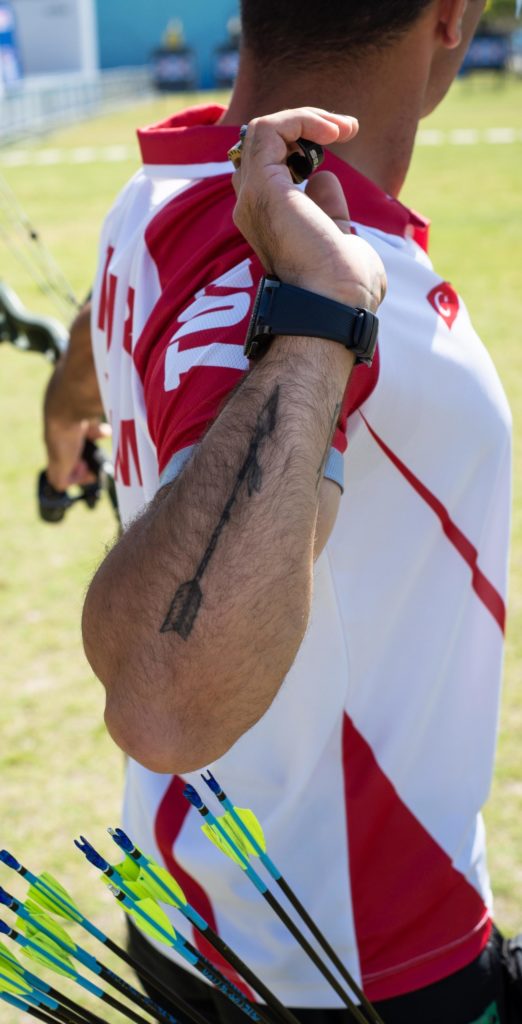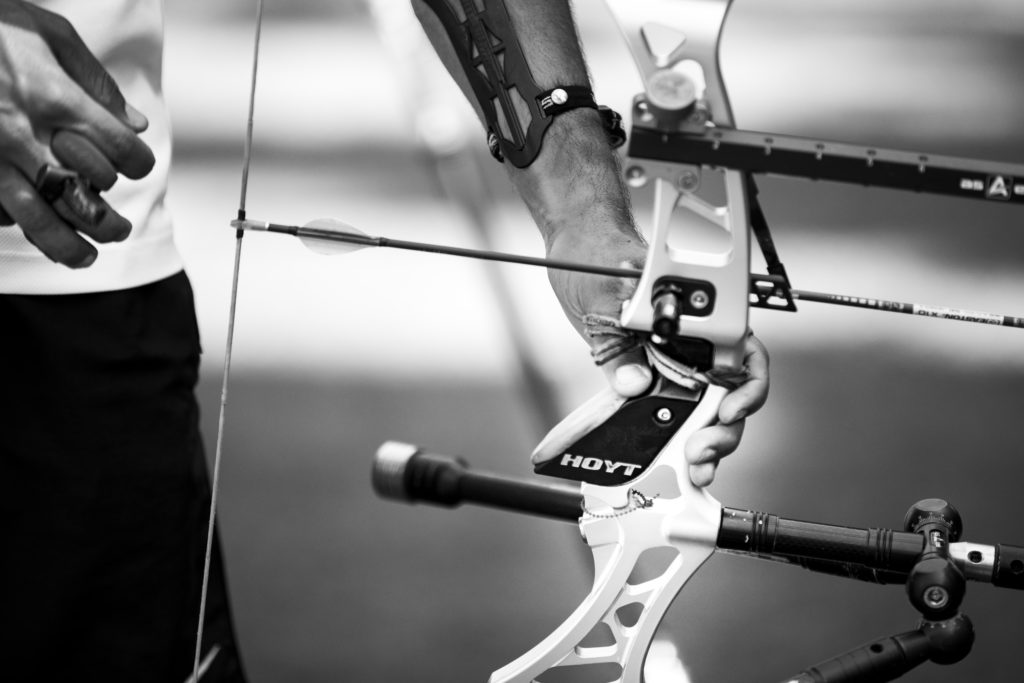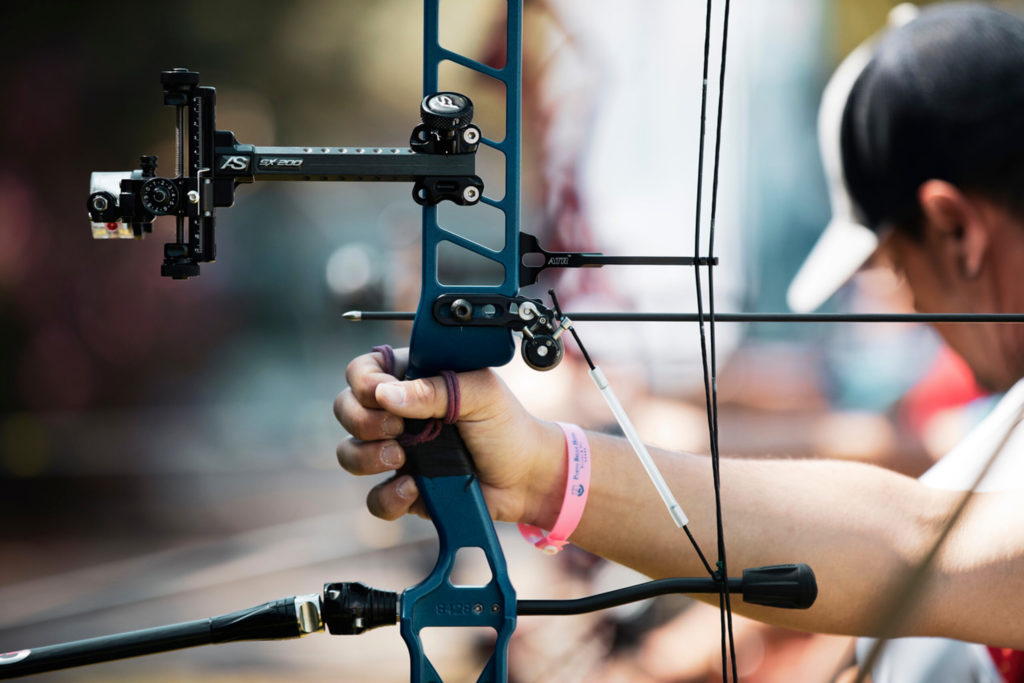Question: I’m currently shooting 27in 850 ACE’s with 60 grain points out of a 68in 35lb bow (I’ve just increased my poundage to assist aiming to get to 100 yards). I’m having an issue and I’m not sure where to start. The bare shaft shoots stiff at 40 yards but as I get out to 80 yards the arrows move right across the face. I can sometimes get the middle but I’ve had to adjust the pin quite a bit. I think I’m shooting pretty consistently form wise and the Beiter button is pretty stiff, so could it be one of the following: a form issue with having such a long break; an arrow issue with the spine breaking down at long distance? I know my arrows are a little light but they should still work.
Answer: This is a great question and an issue many archers will face eventually. Let’s start by getting a few things out of the way. Firstly, for 99% of archers, doing bare-shaft tuning past 30 metres is unreliable. Bare shafts can have secondary reactions past this distance and this will lead you down the wrong path when it comes to tuning. Stick to 30m and closer. Secondly, you should be shooting a minimum of three fletched and three bare shafts when testing. This ensures a rogue, damaged arrow isn’t giving you incorrect readings.
From what you describe, it sounds as if your arrows might be on the weak side and giving you a false reading at 40 yards. If your arrow is way too weak (the fact you’ve had to stiffen your button a lot suggests this), then it can sometimes show stiff at certain points in its usual flight.
Start by double-checking your centreshot and resetting your button to a medium setting – 6.0 on the standard spring for the Beiter button is good enough. Then check your bare shaft at 15-18m and also at 30m. At these distances the bare shaft should consistently be in the group with your fletched arrows. If it’s not then you need to adjust the tune but only by adjusting nocking point, draw weight, arrow length or arrow spine. These are the factors you should be adjusting to get your basic tune; the button is only there for fine tuning farther down the road.
Then, check your arrow flight is clean with two tests. First, shoot some bare shafts at extreme close range (one or two metres from the target) and observe the impact angle. If the arrow has a strong, consistent sideways angle then this could indicate you need to revisit your bare-shaft test or check for clearance issues. Second, place a 122cm face with the white side facing you and shoot at 30m with both your bare-shaft and fletched arrows.
Observe your arrow flight, there should be some oscillation as the arrow comes out of the bow and then a generally stable flight. If there’s a pronounced angle or kick to one side this again indicates you may need to revisit previous steps. Brightly coloured nocks help with this test.
The above steps will give you a tune that is more than capable of shooting consistent gold-sized groups at 70m (80 yards). Don’t worry about doing bare-shaft tests at these distances – even top archers can have bare shafts that veer across the width of the face here, so it’s not worth your time.
Lastly, if it’s your entire group (fletched and bare) that moves right as you go to longer distances, then this is likely to be due to you canting your bow. Canting refers to ‘angling’ the bow slightly to the right or left (when viewed from behind the shooting line), and this is by far the most common cause of groups moving as the distance changes.
If you angle your bow even slightly right, then by 80 yards your arrows can be as far as the black or white. You can get a Beiter 12mm sight pin that allows you to slide a little spirit level on the bottom and is great for checking and eliminating any canting quickly, but this isn’t legal in competition for recurve archers so only use it in practice.
To conclude, follow the basics at closer distances for your initial tune, and make sure your bow is straight. If the above doesn’t help then it’s a case of checking any clearance issues and fixing these. Happy shooting!
ASHE MORGAN
Thanks to Simon White for the question.
Question: There’s a lot of talk about looking for good ‘arrow flight’ but people at my club say different things about my arrows when they’re in the air and I’m not sure exactly what I should be looking for – or at what distance. Please help.

Answer: When people characterise ‘good arrow flight’ they are generally referring to the arrow exiting the bow smoothly and settling down on the central line to the target quickly. Looking from behind, it will seem that the arrow has a nice, level, smooth flight trajectory all the way to the target. It can be difficult to process feedback from other archers on this subject, as, ultimately, they are commenting on a symptom without really understanding a root cause. This isn’t helped by the fact that people will always have different opinions and will observe and report events differently.
Due to the physics of arrow aerodynamics, the arrow will always flex all the way to the target. Although the arrow flexes left and right, the front and rear nodes of the arrow always stay on line to the target. All the while the arrow is rotating as well as flexing.
Trying to see what the arrow is doing mid flight is pretty much possible without slow-motion cameras placed along the range. When an arrow has poor flight characteristics it can be hard to diagnose the issue as the problem could well be lurking in one of several places. Major factors that cause observed poor arrow flight are: a poor release; incorrect arrow spine; incorrect arrow trim; bow tuning; and weather.
A poor ‘plucked’ release on a recurve bow will send the rear of the arrow gyrating as the oscillation pattern of the sting gets changed. If an arrow spine is too stiff the arrow can kick way out to the left of the bow before the vanes stabilise and steer the arrow. Again, if the spine is too weak it will lead to a unique set of problems.
It is possible to configure the trim of an arrow incorrectly. The vanes might be too big or small and the points too heavy or too light. The balance point of the arrow might be too far forward or aft. Correct nock fit is also an important factor in how smoothly the arrow departs the string. Getting a properly configured arrow for the bow and distance shot is of paramount importance, as is bow tuning. An incorrectly tuned bow is a major contributor to poor arrow flight. Limb alignment, pressure button setting, arrow rest setting, nock point height and brace height will all play their part on how the arrow departs from the bow.
The real devil in the mix is weather. Most of the other issues I’ve mentioned are static, constant problems. The weather is changeable, creating a dynamic problem that might be there one second and gone the next. The longer the shooting distance the greater the chance of the weather interfering with the shot. A crosswind can blow the rear of the arrow out sideways and give an illusion of poor arrow flight. Conditions might be still on the shooting line but blowing down range, giving an observed sudden change of flight. Humidity and precipitation present added issues for the arrow to deal with.
Taking all of the above into account, it’s extremely difficult to identify where the potential issues are. If you are certain that something is critically wrong, you need to go back to basics and go through a structured process of elimination. First of all, make sure that you’re using the correct arrow in terms of length and spine. Then, ensure that the arrow trim is correctly configured for the type of shooting that’s going to be asked of it.
Next up is to do some diligent bow tuning with the configured arrows. Try doing a mix of bare-shaft and walk-back tuning regimes. Once sure of the equipment calibration you can then turn your focus to the human part. Refining technique and smoothing out the release always helps in any situation.
Finally, I would advise trying not to peek or see what the arrow is doing as it leaves the bow. My coaching experience has shown me that this often leads to a degree of head movement. There is a small passage of time during which the arrow has left the string but is still in contact with the bow.
Although it’s only a split second, the archer can still affect the arrow and bow with body movement. Keep dead still and shoot the shot with great technique. Now that most phones have video capabilities, you can get someone to stand directly behind you and take some footage. You should then be able to slow this down and observe what’s happening. This will enable you to make a direct comparison between before and after making changes to arrow configuration and tuning.
ADRIAN TIPPINS
Question: My coach has always told me I should let down if my form or set-up of a shot feels off, yet the elite shooters never seem to do this. Which is the best option?
Answer: Your coach’s advice is spot on. If your set-up feels uncomfortable or wrong in any way, then let down and start over. There are a couple of valid reasons why you don’t see archers shooting head-to-head matches at major tournaments, such as the Olympics, doing this.
Firstly, they are shooting against a very tight clock. Archers have just 20 seconds to execute their shot so have to be careful not to hold for too long. So where they might let down during practice, in a timed head-to-head match they won’t. If you’ve been watching these matches you’ve probably heard the coach or a teammate begin to count down the seconds; occasionally, competitors are forced to execute even if the result isn’t favourable.
Those elite archers do, of course, have very good form and trusty execution, so in most cases they are well set up to begin with and the clock is less of a problem. On a field course, where there is usually no time limit, you are permitted up to four draws before you are compelled to shoot; you will find quality archers coming down any time they are not perfectly happy with their set-up at anchor.
So if, at present, you are in a competitive environment where the clock is not as demanding as it is at elite level, then the best advice is always to let down and start over any time you lose trust in the set-up of at anchor or at any time in the process.
ROY ROSE



